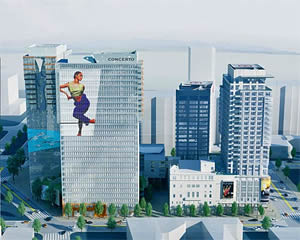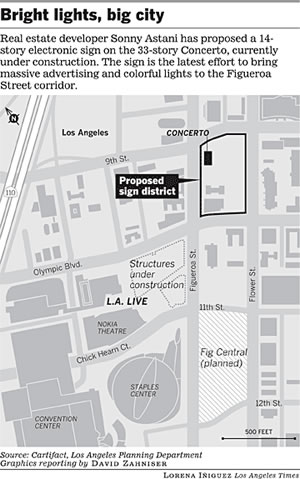Inspired by ‘Blade Runner’, a developer wants 14-foot-high animation on condos.
Source :: LA Times dot com
Date :: 01 27 2008
By :: David Zahniser, Los Angeles Times Staff Writer
Sonny Astani walked into a Westwood movie theater in 1985 and saw the film that change
d his life: “Blade Runner,” the science-fiction tale that imagined a dystopian Los Angeles where jet-powered cars zoom past skyscrapers covered with enormous, cinematic advertisements.

EYE-CATCHING: An artist’s rendering shows an LED-generated image rising above the city.
Decades later, the Iranian-born businessman is determined to bring some of those futuristic images to life. His plan? Attach an animated sign 14-stories tall on the 33-story condominium project he is building in downtown L.A.
The proposed sign would loom 12 stories above the sidewalk at 9th and Figueroa streets, facing the 110 Freeway. And city planners say it would represent a first in the city’s residential architecture — a sheet of light-emitting screens spaced close enough to form a vast electronic image, yet far enough apart to allow occupants to look outside.
“My intent is to do something so unique that people will drive downtown to see it,” said Astani, who moved to the United States in 1976. “It will make the building famous for the people who live there.”
Astani’s proposal is only the latest controversial effort to bring massive advertising and colorful light shows to the neighborhood anchored by Staples Center and L.A. Live, the hotel and entertainment complex that includes the recently opened Nokia Theatre.
Civic boosters promised two years ago that L.A. Live would transform Figueroa’s entertainment district into Times Square West — a California counterpart to the bright lights and in-your-face advertising seen at Broadway and 42nd Street in Manhattan.
Although much of L.A. Live is under construction, the district around Staples already has some of those colorful lights, including the red squares that percolate like soda bubbles on the exterior of the Met Lofts and the spotlights at Nokia that strafe the sky, giving concerts and games the look of a Hollywood premiere.

Warner Bros Pictures
PROTOTYPE: This image of an animated advertisment in the film “Blade Runner” inspired Sonny Astani in the design of his condominium project near the 110 Freeway in downtown Los Angeles. Critiques say it could dominate the night sky.
Astani’s plan seeks the creation of a special district where at least two high-rises could be partly covered with rows of tiny panels embedded with LEDs, or light-emitting diodes — a concept viewed by some at City Hall as the next frontier in outdoor advertising.
Although office towers in Los Angeles already have “supergraphics” — enormous vinyl sheets stretched across one side of a building — those images are static. Should Astani succeed, sign companies looking to show animated advertising could view the city’s high-rises as enormous blank canvases.
So far, the concept has been greeted skeptically by neighborhood activists west of downtown, who said the light shows on the Nokia already have had a profound effect on their night sky.
“I’m not some shrinking violet afraid of the urban environment,” said Mitzi March Mogul, who lives three miles east of downtown. “We used to see the klieg lights for the Carthay Circle Theater or Grauman’s Chinese. But it wasn’t all the time. Most nights you could look up and actually see stars, and now you can’t. There’s nothing left.”

The Pico Union Neighborhood Council has taken up the issue of the L.A. Live spotlights, with some members calling for their removal. Anschutz Entertainment Group, the developer of L.A. Live, said it has begun talks with city officials to address some of the complaints.
“We’re still developing the entertainment district and fine-tuning all of the elements of it,” said AEG spokesman Michael Roth. “And we feel all of the audio and visual elements are appropriate for the location.”
Meanwhile, more signs are on the way. In November, the City Council approved Fig Central, a hotel and condominium complex across from Staples Center that will have at least one 330-foot-long band of animated advertising. And at least seven more electronic signs are planned for the rest of L.A. Live, according to city officials.
The courtyard outside Nokia Theatre has 12 LED signs — enormous screens that intersperse concert footage with advertisements for mobile phones and Coca-Cola. The theater is adorned with more screens and billboards, a fact that disappoints some neighbors.
“When I drive back here at night, I’m astounded that that kind of illumination is permissible,” said Victor Citrin, a teacher who lives three blocks from the theater. “What Nokia has turned into is just a giant billboard of massive ads.”
Councilwoman Jan Perry, who represents the Figueroa Corridor, said the neighborhood could eventually “hit a breaking point” in terms of brightness. But she sounded intrigued by Astani’s plan, which would put a sign on the project known as Concerto, and a second on a high-rise planned next door.
“It might actually be beautiful,” she said. “It might actually be art, as opposed to just ads.”
Los Angeles has long had a love-hate relationship with outdoor advertising. The City Council first attempted to regulate billboards in 1899, when many signs were simply plastered on fences for the benefit of those who traveled by horse or trolley.

That first law, which sought to limit billboards to 6 feet high, drew a furious legal challenge from H. Gaylord Wilshire, the billboard magnate whose name appears on one of the city’s most famous streets, Wilshire Boulevard. The council softened the law a year later, inaugurating a debate over billboards that has raged from generation to generation.
The billboard question seemed finally to have been answered in 2002, when then-Councilwoman Cindy Miscikowski, after 14 years of trying, won passage of a ban on outdoor advertising. But that law also contained a provision allowing the creation of “supplemental use districts,” places like Hollywood, where billboards would be permitted in large numbers.
Astani, 54, has submitted a proposal for a sign district on the block bounded by 9th Street, Olympic Boulevard, Figueroa and Flower streets. But he argues that his LED displays should not be considered billboards.
To make the images less blinding, the signs would have a brightness of only 1,200 candelas at night — roughly one-sixth the intensity of the signs found at L.A. Live, Astani said. And because the movements of his LED sign would be slower than the images on a television screen, Astani contends, his 14-story sign would be graceful, not gaudy.
“We don’t want to create a monster,” Astani said. “If this is bright or intrusive, we cannot sell the condominiums. It will have to be so unique and unobtrusive that people will be proud to live behind it.”
Astani’s inspiration can be found in the first 10 minutes of “Blade Runner,” the 1982 film which showed a skyscraper-sized advertisement portraying a Japanese woman smiling before popping a snack into her mouth. Astani says an image, such as that of a flying sea gull, could now even travel from one building to the next.
Such untried concepts have left city officials struggling to find ways of regulating brightness, the amount of text and the content.
If approved, the signs would contain artistic content during 10% of their operation, with another 10% devoted to community announcements, according to Astani’s proposal. The sign rules also would dictate the speed with which the animated images change.
Those proposals do not reassure neighborhood activists, who say any sign facing a freeway is a billboard, regardless of the brightness or the tastefulness of the content.
Most of the companies installing the new lights have ties to City Hall. L.A. Live builder Anschutz Entertainment Group has given $485,000 to causes backed by Mayor Antonio Villaraigosa. The developer of Fig Central has given $100,000; Astani has given $150,000.
Astani said the Planning Department has been cautious in its review of the proposed sign district. But he argued that the time will have been well spent if he can succeed in giving his building cutting-edge technology — the kind found in “Blade Runner.”
“There’s not one day that I don’t think of that movie,” he said.

Recent Comments